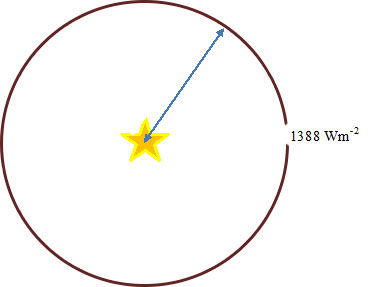Solar energy [ctd.]

2.3 Potential of solar energy
As we discussed in the previous article, Sun is a huge nuclear fusion reactor. It is a spinning ball of gases around which all the planets revolve. Its energy radiates out to space at a tremendous rate but declines with increasing distance from the Sun.
 The amount of solar irradiance per unit area per unit time on a surface normal to the Sun’s rays at the Earth’s mean distance from the Sun (one astronomical unit away from the Sun) is about 1388 Wm-2. This value is often known as the solar constant. Solar energy is partially absorbed and reflected back by the atmosphere. Therefore, solar constant is measured using satellites which allow to find out the amount of solar power received by Earth’s atmosphere before entering the atmosphere.
The amount of solar irradiance per unit area per unit time on a surface normal to the Sun’s rays at the Earth’s mean distance from the Sun (one astronomical unit away from the Sun) is about 1388 Wm-2. This value is often known as the solar constant. Solar energy is partially absorbed and reflected back by the atmosphere. Therefore, solar constant is measured using satellites which allow to find out the amount of solar power received by Earth’s atmosphere before entering the atmosphere.
1388 Wm-2 of solar power reaching the atmosphere means one square meter of the Earth’s atmosphere normal to the EM waves receives solar power equivalent to 14 light bulbs each rated at 100 W (28 light bulbs each rated at 50 W)!
The basic math of the Sun
Solar irradiance outside the Earth’s atmosphere~ 1388 Wm-2
Distance from the Sun to Earth~ 1.5×1011 m [1]
Surface area of a sphere having a radius of 1.5×1011 m = 4π (1.5×1011 m)2
= 2.8 1023 m2
Luminosity of the (solar power at the Sun) Sun = 2.8 1023 m2 1388 W m-2
= 3.9 1026 W
Current global power demand = 17.5 1012 W [6]
Note that, 
This implies that
- Our Sun generates 2.2×1013 times the global power demand. In other words, it generates 2.2×1013times energy that we consume and it is enough to light up 2.2×1013 Earth-like planets.
- The amount of energy generated by the Sun in a second is equal to the amount of energy consumed by us for 2.2×1013
Note that, 
So…
The amount of energy generated by the Sun in one second is enough to fulfill the entire global energy demand for almost 697615 years (at current rate of energy consumption)!
The solar irradiance at the Earth’s surface is always less than the solar constant largely due to the absorption and reflection of solar energy by some gases in the atmosphere. In addition, solar irradiance varies from place to place on the Earth’s surface, largely due to the fact that different places on the Earth are irradiated at different angles of incidence (Earth is not a disk but a sphere). However, our planet still receives more than enough energy from the Sun to meet our entire energy demand.
CONTINUED
